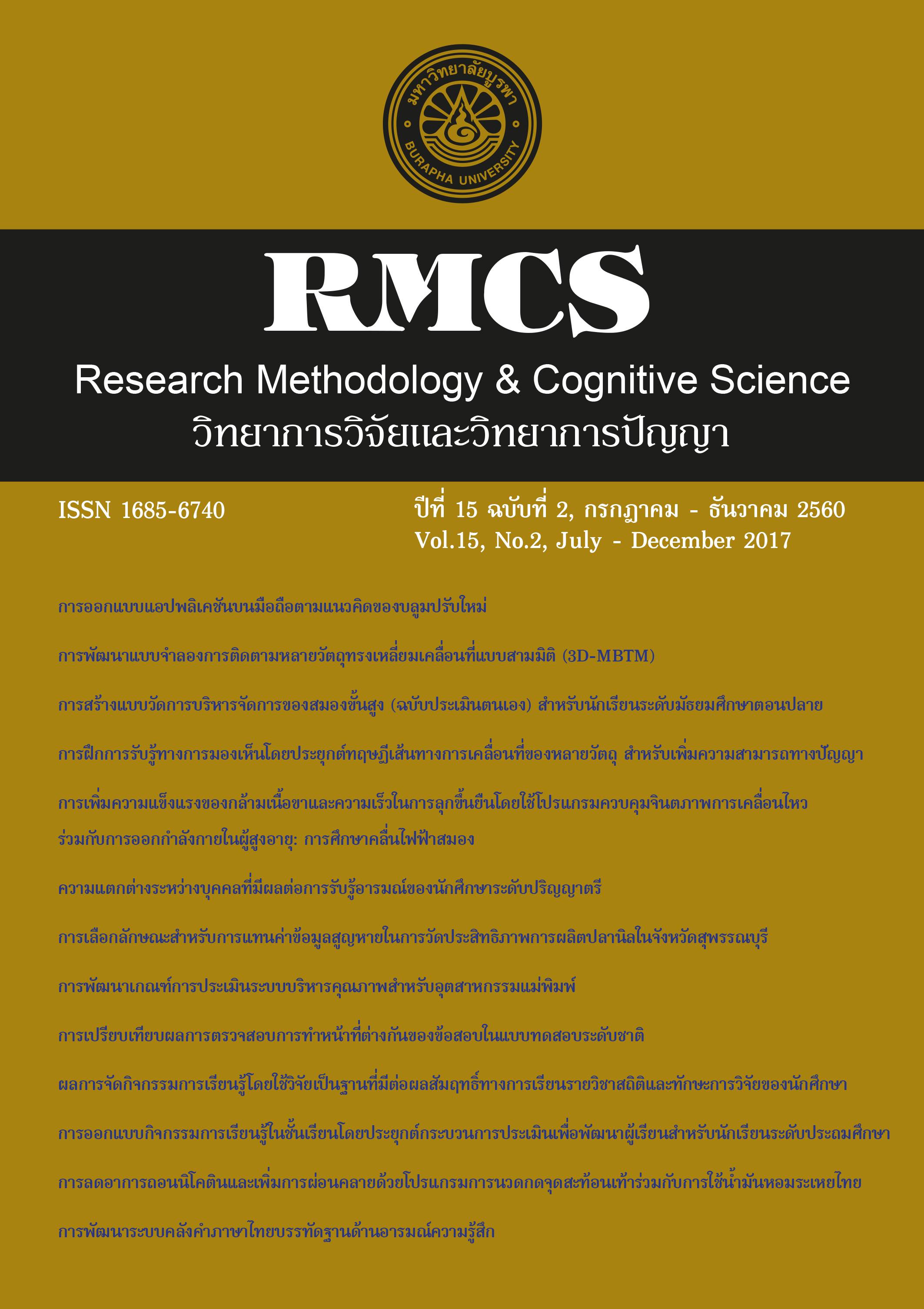การพัฒนาแบบจำลองการติดตามหลายวัตถุทรงเหลี่ยมเคลื่อนที่แบบสามมิติ (3D-MBTM) สำหรับเพิ่มความสามารถด้านมิติสัมพันธ์ของวัยรุ่นตอนต้น
Main Article Content
บทคัดย่อ
ความสามารถด้านมิติสัมพันธ์เป็นองค์ประกอบหนึ่งของสติปัญญามนุษย์ ที่มีความสำคัญต่อการดำรงชีวิต
ประจำวันของแต่ละบุคคล และมีความแตกต่างกันระหว่างบุคคล อีกทั้งยังเป็นความสามารถที่อาจพัฒนาให้ทัดเทียม
กันได้โดยการฝึกฝน โดยเฉพาะการฝึกด้วยกิจกรรมผ่านหน้าจอคอมพิวเตอร์ การวิจัยนี้มีวัตถุประสงค์เพื่อพัฒนา
แบบจำลองการติดตามหลายวัตถุทรงเหลี่ยมเคลื่อนที่แบบสามมิติ (3D-MBTM) สำหรับเพิ่มความสามารถด้านมิติ
สัมพันธ์ของวัยรุ่นตอนต้น และศึกษาผลของการฝึกด้วยแบบจำลองการติดตามหลายวัตถุทรงเหลี่ยมเคลื่อนที่แบบ
สามมิติที่พัฒนาขึ้น ด้วยการเปรียบเทียบกับกลุ่มควบคุม กลุ่มตัวอย่างเป็นนักเรียนระดับมัธยมศึกษาตอนต้น โรงเรียน
แสนสุข ปีการศึกษา 2559 จำนวน 60 คน อาสาสมัครเข้าร่วมการวิจัย จัดเข้ากลุ่มโดยวิธีการสุ่ม (กลุ่มทดลอง
จำนวน 30 คน และกลุ่มควบคุม จำนวน 30 คน) กลุ่มทดลองได้รับการฝึกด้วยแบบจำลองการติดตามหลายวัตถุ
ทรงเหลี่ยมเคลื่อนที่แบบสามมิติ ผ่านหน้าจอทีวี จำนวน 12 วัน วันละ 30 นาที ส่วนกลุ่มควบคุมไม่ได้รับการฝึก
เก็บรวบรวมข้อมูลโดยใช้แบบทดสอบ Paper folding & form board test, Card rotations test และ Mental
rotations test สถิติที่ใช้ในการวิเคราะห์ข้อมูล ได้แก่ Descriptive statistics และ MANOVA
ผลการวิจัยปรากฏว่า แบบจำลองการติดตามหลายวัตถุทรงเหลี่ยมเคลื่อนที่แบบสามมิติ ประกอบด้วย
5 ขั้นตอน ได้แก่ การแสดง การบ่งชี้สิ่งเป้าหมาย การเคลื่อนที่ การตอบ และการแสดงผล นอกจากนี้ผลการนำแบบ
จำลองการติดตามหลายวัตถุทรงเหลี่ยมเคลื่อนที่แบบสามมิติที่พัฒนาขึ้นไปใช้ พบว่า หลังการทดลองกลุ่มทดลองมี
คะแนนมิติสัมพันธ์สูงกว่า และใช้เวลาตอบน้อยกว่า เมื่อเทียบกับก่อนการทดลอง และเทียบกับกลุ่มควบคุม อย่างมี
นัยสำคัญทางสถิติ (p<.05) สรุปได้ว่า การฝึกด้วยแบบจำลองการติดตามหลายวัตถุทรงเหลี่ยมเคลื่อนที่แบบสามมิติ
อย่างต่อเนื่อง สามารถช่วยเพิ่มความสามารถด้านมิติสัมพันธ์ของวัยรุ่นตอนต้นได้
Article Details
เอกสารอ้างอิง
Christensen, L. B., John, R. B., & Turner, L. A. (2015). Research method, design, and anlysis (12th ed.).London: Pearson Education.
Christou, C., Jones, K., Pitta-Pantazi, D., Pittalis, M.,Mousoulides, N., Matos, J. F., et al. (2007, February 22-26). Developing student spatial ability with 3D software applications. In 5th Congress of the
European Society for Research in Mathematics Education. Larnaca, Cyprus.
Cohen, C. A., & Hegarty, M. (2014). Visualizing cross sections: Training spatial thinking using interactive animations and virtual objects. Learning and Individual Differences, 33, 63-71.
Ganley, C. M., Vasilyeva, M., & Dulaney, A. (2014). Spatial ability mediates the gender difference in middle school students’ science performance. Child Development, 85(4), 1419-1432.
Gardner, H. (2011). Frames of mind: The theory of multiple intelligences (3rd ed.). New York: BasicBooks.
Jahn, G., Wendt, J., Lotze, M., Papenmeier, F., & Huff, M. (2012). Brain activation during spatial updating and attentive tracking of moving targets. Brain and Cognition, 78(2), 105-113.
Joyce, B., Weil, M., & Calhoun, E. (2009). Models of teaching (8th ed.). Boston: Pearson Education.
Kell, H. J., Lubinski, D., Benbow, C. P., & Steiger, J. H. (2013). Creativity and technical innovation: Spatial ability’s unique role. Psychological Science, 24(9),1831-1836.
Kornkasem, S., & Black, J. B. (2015). Formation of spatial thinking skills through different training methods. Cognitive Processing, 16(1), 281-285.
Kosslyn, S. M., Shephard, J. M., & Thompson, W. L. (2007). Spatial processing during mental imagery: A neurofunctional theory. In Mast, F. & Jancke, L.(Eds.), Spatial processing in navigation, imagery
and perception (pp. 1-15). New York: Springer.
National Science Board [NSB]. (2010). Preparing the next generation of stem innovators: Identifying and developing our nation’s human capital. Virginia: National Science Foundation.
Neubauer, A. C., Bergner, S., & Schatz, M. (2010). Twovs. Three-dimensional presentation of mental rotation tasks: Sex differences and effects of training on performance and brain activation.
Intelligence, 38(5), 529-539.
OECD. (2016). Pisa 2015 results in focus. Paris: OECD.
Offce of the National Economic and Social Development Board. (2011). The eleventh national economic and social development plan (2012-2016). Bangkok, Thailand: National Economic and Social
Development Board, Offce of the Prime Minister.
Penphu, W., & Kornpetpanee, S. (2017). Enhancing the visual perception ability of motorcycle taxi riders using 3D motion object tracking training program. Research Methodology & Cognitive
Science, 15(1), 54-64.
Ptito, M., Kupers, R., Lomber, S., & Pietrini, P. (2012). Sensory deprivation and brain plasticity. Neural Plasticity, 2012.
Pylyshyn, Z. W. (2001). Visual indexes, preconceptual objects, and situated vision. Cognition, 80(1-2), 127-158.
Pylyshyn, Z. W., & Storm, R. W. (1988). Tracking multiple independent targets: Evidence for a parallel tracking mechanism. Spatial Vision, 3(3), 179-197.
Rehman, U. A., Kihara, K., Matsumoto, A., & Ohtsuka, S. (2015). Attentive tracking of moving objects in real 3D space. Vision Research, 109, 1-10.
Samsudin, K., Raf, A., & Hanif, A. S. (2011). Training in mental rotation and spatial visualization and its impact on orthographic drawing performance.Educational Technology & Society, 14(1), 179–186.
Schneck, C. M. (2010). A frame of reference for visual perception. In Kramer, P. & Hinojosa, J. (Eds.), Frames of reference for pediatric occupational therapy (3rd ed., pp. 349-389). Hong Kong, China:
Lippincott Williams & Wilkins.
Tanudtanusilp, P., Kornpetpanee, S., & Ruangtip, P. (2017). Increasing spatial recognition ability using three dimensional multiple object tracking (3D-MOT) task for upper secondary school students:
An electroencephalogram study. Research Methodology & Cognitive Science, 15(1), 73-92.
Treisman, A. (2002). Features and objects in visusal processing. In Levitin, D. J. (Ed.), Foundations of cognitive psychology: Core readings (pp. 399-413). Massachusetts: MIT.
Ung, P., Ngowtrakul, B, Chotpradit, R., & Thavornwong, N. (2016). Spatial ability test for upper-elementary school student: Confrmatory factor and normative data analysis. Journal of the Association of
Researchers, 21(2), 48-57.
Uttal, D. H., Meadow, N. G., Tipton, E., Hand, L. L., Alden, A. R., Warren, C., et al. (2013). The malleability of spatial skills: A meta-analysis of training studies. Psychological Bulletin, 139(2), 352-402.
Vasquez, J. A., Sneider, C., & Comer, M. (2013). Stem lesson essentials: Integrating science, technology, engineering, and mathematics. Portsmouth, New Hampshire: Heinemann.
Wright, R., Thompson, W. L., Ganis, G., Newcombe, N. S., & Kosslyn, S. M. (2008). Training generalized spatial skills. Psychonomic Bulletin & Review, 15(4), 763-771.
Zhang, X., Koponen, T., Rasanen, P., Aunola, K., Lerkkanen, M. K., & Nurmi, J. E. (2014). Linguistic and spatial skills predict early arithmetic development via counting sequence knowledge. Child Development,
85(3), 1091-1107.

